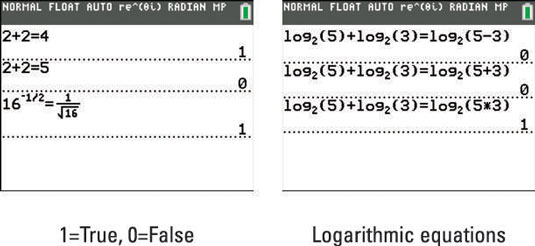The often overlooked Test menu on the TI-84 Plus enables you to use your calculator in creative ways to solve problems. Do you want to do better on your next standardized test? Some of these tips just might help your score.
Understanding Boolean logic
Have you ever wondered how your calculator “thinks"? Your calculator employs Boolean logic and prefers to work with the integers 1 and 0. These are called truth values with 1 meaning True and 0 meaning False. Boolean operators like and, or, and not help your calculator organize its “thoughts.”
How does this help you? Just remember this: 1=True and 0=False.
Comparing numbers on the TI-84 Plus
The Test menu has a list of relational operators that you can use to compare values. To access the Test menu, press [2nd][MATH].
Follow these steps to compare two expressions:
Enter an expression.
If necessary, press [2nd][MODE] to access the Home screen. See the first screen.
Press [2nd][MATH] to access the Test menu.
See the second screen.
Press the number associated with the relational operator you want.
Enter an expression.
This is illustrated in the third screen.
Press [ENTER] to evaluate the comparison statement.
Remember, 1=True and 0=False. Because 6 is larger than 3, entering the expression 5+1 > 3 produced the truth value of 1 (True). Similarly, 6 is not smaller than 3, so entering the expression 5 + 1 < 3 produced the truth value of 0 (False). In this way, you can use inequalities to compare two values.

Testing equivalent expressions on the TI-84
Does 2 + 2 = 4? You can check and see by entering the equation in your calculator. Try it! Press [2nd][MATH][ENTER] to type an = sign. Of course, you’ll probably want to use this feature for slightly more complicated problems. See the first screen.
Have you ever seen a question like this on a standardized test?
Evaluate log2(5) + log2(3)
A) log2(5–3) C) log2(5*3)
B) log2(5+3) D) log2(5/3)
As long as you can enter a logarithm in your calculator
you can solve this problem. Enter the expression, insert the = sign from the Test menu, and then enter one of the answers. When your calculator returns 1 (True), you have found the correct answer. See the second screen.
Press the up-arrow key to scroll through your previous calculations. When a previous entry or answer is highlighted, press [ENTER] to paste into your current entry line (where you can edit the expression.)

Using Logic commands on your TI-84 Plus
Compound inequalities are two inequalities that are joined by the word "and" or by the word "or." Often, an "and" inequality is written in a shortcut form where two inequalities are sandwiched together. For example, 2 < x < 5 can also be written as a compound inequality: x > 2 and x < 5.
To access the Logic menu, press
See the first screen.
For an “and” compound inequality to be true, both statements must be true. For an " or" compound inequality to be true, only one of the statements must be true. See the third screen.
Two more commands are also found in the Logic menu: xor and not. These are used almost exclusively in programming. The command xor means exactly one statement is true. The not command flips everything that is true to false, and vice versa.

